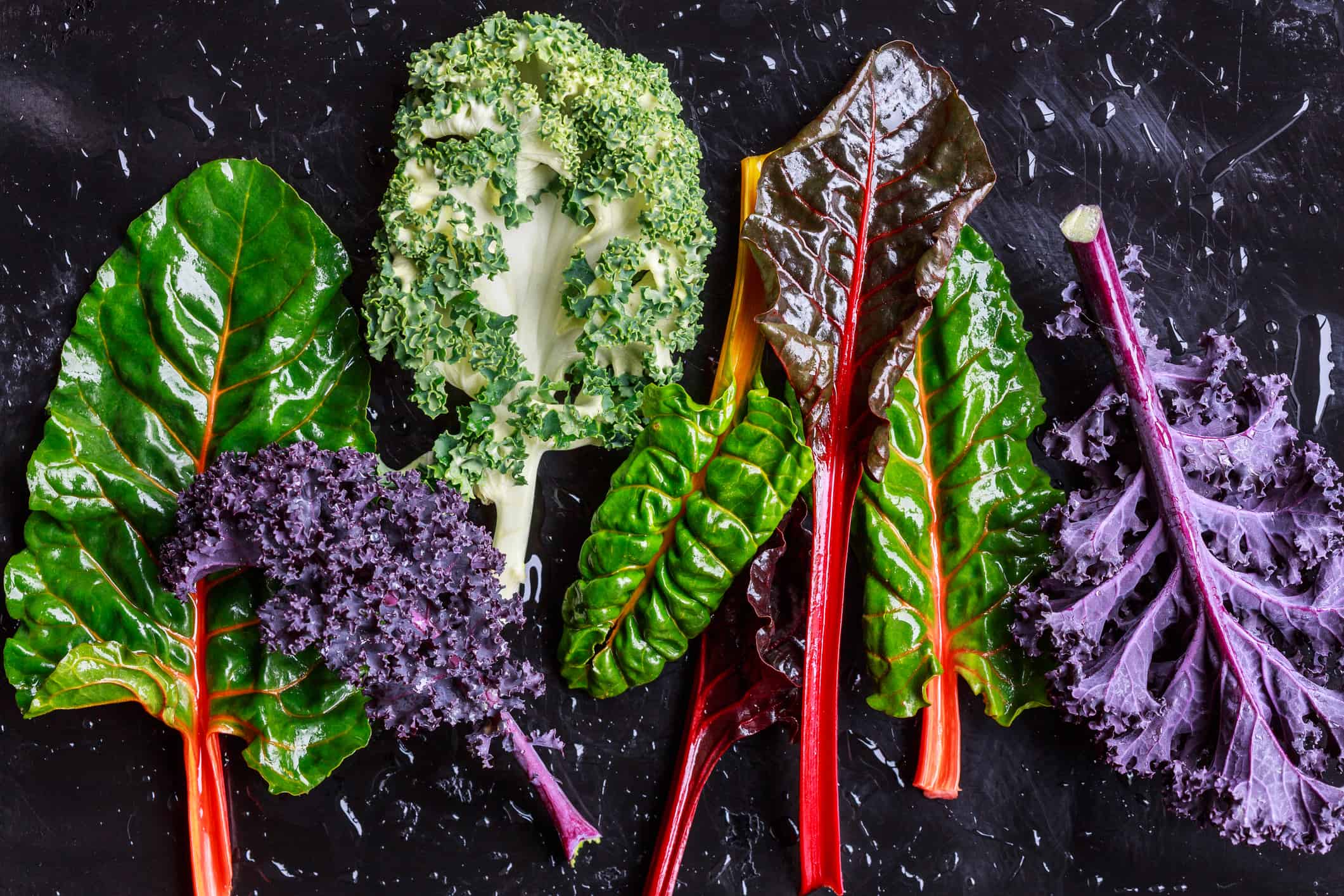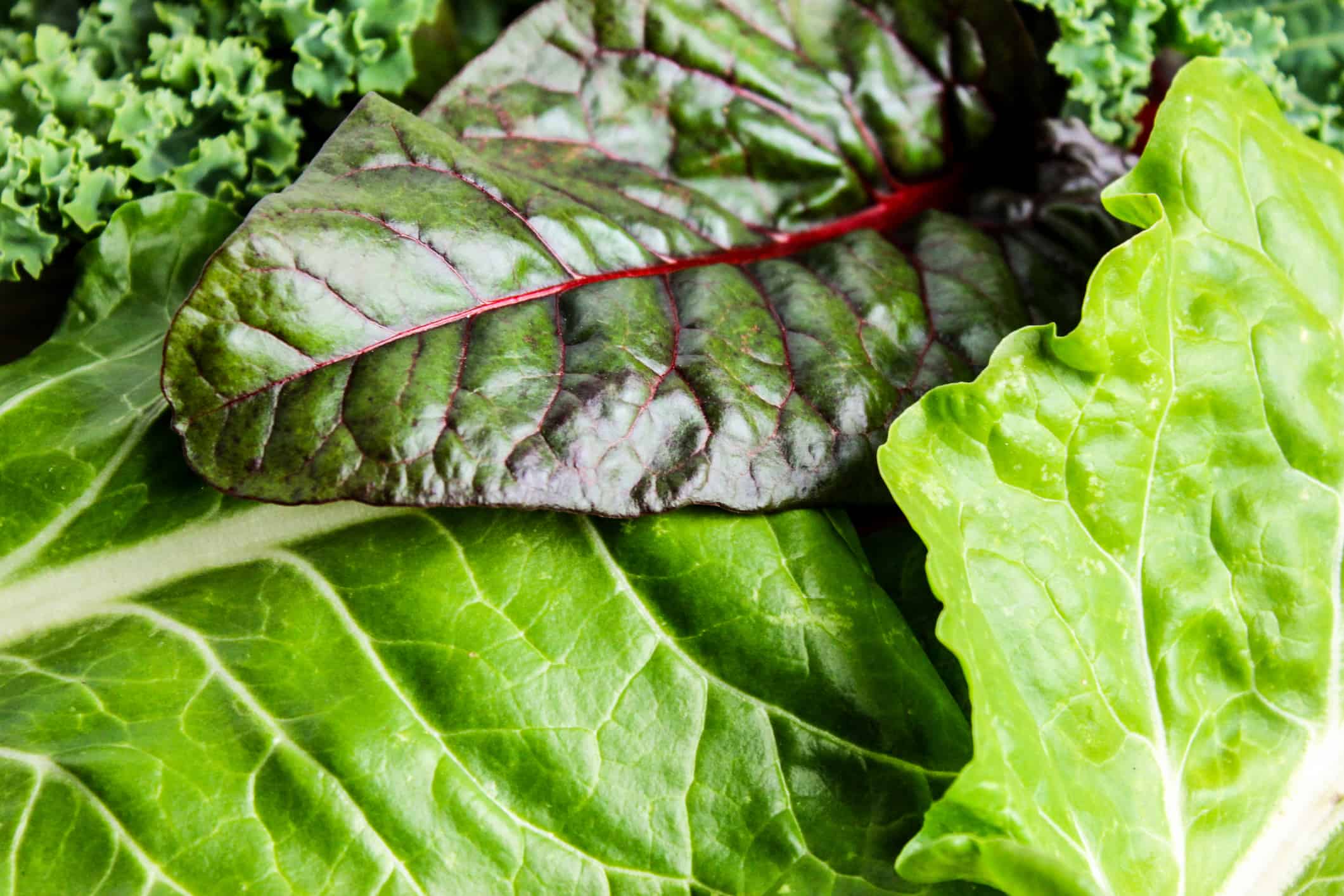Swiss chard and kale are both leafy greens that have become popular in recent years due to their nutritional benefits. They are both leafy green vegetables full of nutrients, but they do have some important differences. In this blog post, we’ll take a look at the main differences between Swiss chard and kale so you can make an informed decision about which one is best for your needs. We’ll discuss everything from taste to nutrition content and how each vegetable should be prepared before eating. So let’s dive right into it: what makes Swiss chard different from kale?

The differences between Swiss chard and kale come down to taste, texture, nutrition and color.
©iStock.com/Quanthem
Comparing Swiss Chard to Kale
The differences between Swiss chard and kale come down to taste, texture, and nutrition. In terms of taste, Swiss chard is milder than kale, with a slightly salty flavor. Texture-wise, kale is tougher and more fibrous, whereas Swiss chard has a softer texture. Nutritionally speaking, both are packed with vitamins A & C as well as calcium, but there are a few differences to discuss. Lastly, when it comes to cooking them, kale can be eaten raw or cooked but works best in soups or stir-fries, while Swiss chard works better cooked in dishes such as omelets or quiches since its leaves become tender when heated. We will break down these differences, plus more, below.
| Characteristic | Swiss Chard | Kale |
|---|---|---|
| Plant Family | Beet Family | Cabbage Family |
| Scientific Name | Beta vulgaris | Brassica oleracea |
| Growth | Cool season annual, hardy to 15 °F | Cool season biennial, hardy to 10 °F |
| Colors | Red, green, white, rainbow | Green, purple |
| Uses | Salad, stir fry, soup, omelet, wrap | Chips, salad, stir fry, soup, stew |
| Origin | Sicily | Mediterranean |
| Common Names | Silver beet, perpetual spinach, seakale beet, chard, Swiss chard | Kale, leaf cabbage |
| Nutrients | More potassium, magnesium, vitamin E, vitamin A and vitamin K than kale. | More protein, vitamin C, calcium, and folate than Swiss chard. |
Key Differences Between Swiss Chard and Kale
The key differences between Swiss chard and kale are their nutrient content, taste, and uses. They are each full of micronutrients and vitamins, but they contain differing amounts. They are each leafy greens, but they taste different, have different textures, and are used in different dishes. We will go into this in more detail in a moment.

Swiss chard is milder than kale, with a slightly salty flavor and kale is tougher and more fibrous.
©iStock.com/lauraag
Plant Family
Swiss chard is a member of the beet family, while kale belongs to the cabbage family. The scientific name for Swiss chard is Beta vulgaris. The scientific name for kale is Brassica oleracea.
Nutrients
Per 100 grams, Swiss chard has 4.13 grams of carbohydrates, .08 grams of fat, and 1.8 grams of protein.
Per 100 grams, kale has 8.8 grams of carbohydrates, .09 grams of fat, and 4.3 grams of protein.
| Nutrient | 1 Cup Kale | 1 Cup Swiss Chard |
|---|---|---|
| Calcium (mg) | 24 | 18 |
| Potassium (mg) | 79 | 136 |
| Magnesium (mg) | 8 | 29 |
| Vitamin E (mg) | 0.3 | 0.7 |
| Vitamin C (mg) | 19 | 11 |
| Vitamin A (IU) | 1598 | 2202 |
| Vitamin K (ug) | 113 | 299 |
| Folate (ug) | 23 | 5 |
Taste
Kale is described as having a nutty and earthy flavor that is slightly bitter. The leaves are strong tasting but not spicy. They are fibrous and tough to chew.
Swiss chard is described as having a mild earthy taste that is slightly sweet and slightly bitter. Chard leaves are crunchy, watery, and softer than kale.
Swiss Chard vs. Kale: How to Grow
Chard is an ideal vegetable to cultivate as it can grow quickly and easily during the cooler temperatures of spring and fall. Additionally, it has a higher heat tolerance than other greens, making it suitable for growing even in the warmer months. This makes chard a great option for salads when temperatures get too high for other greens.
If you want to grow Swiss chard, you’ll need to find a spot with full sunlight and soil that drains well, with a pH between 6.0 and 7.0. To get a spring harvest, plant the seeds three weeks before the last frost of spring. For a fall harvest, plant them forty days before the frost date for your area. Place the seeds half an inch into the ground and space each plant six inches away from the next, with eighteen inches between each row. If you want to have a continuous supply of chard, sow new seeds at 10-day intervals.
Kale is a hardy and flexible vegetable that is simple to cultivate. It is a biennial plant, meaning it will develop leaves in the first year and then generate a flower stalk in the second or sometimes late in the first year. After this, the plant will form flowers and seeds and then eventually die.
For the best-tasting and most tender leaves, kale needs full sun and rich, well-drained soil. Incorporating compost and nitrogen-rich amendments like blood meal, cottonseed meal, or composted manure into the ground before planting will give the plants an added boost. Kale is best when it grows quickly and matures before temperatures exceed 75 °F or after fall frosts have occurred. Young plants can handle temperatures as low as 25 °F, while mature plants can withstand very cold temperatures. However, hot temperatures will lead to slower growth and a bitter flavor.
For spring kale crops, plant seeds four weeks before the last spring frost. They will germinate once the soil reaches 40 °F. For a fall crop, sow seeds 90 days before the first fall frost. Plant seeds half an inch deep, 1 inch apart, with rows 18 inches apart.

Chard is an ideal vegetable to cultivate as it can grow quickly and easily during the cooler temperatures of spring and fall.
©iStock.com/photokitchen
Colors
Swiss chard comes in many colors. Ruby chard has bright red stems and green leaves. Gold chard has yellow stalks and green leaves. There are pink, orange, white, and green stalked varieties too.
Kale comes in varieties with green, white, red, and purple leaves. Lacinato kale has dark blue leaves that are slender and textured. Red Russian kale is purple-red with oak-shaped leaves. Siberian kale has gigantic leaves that are green and ruffled along the edges.

Both kale and Swiss chard are packed with essential vitamins, minerals, and antioxidants that help promote overall health.
©iStock.com/Tetiana Kolubai
Uses
Swiss chard is steamed and sauteed. It is also used in stir fry, soup, salads, wraps, and omelets.
Kale is used for making kale chips, salads, stir-fries, soups, and stews. It is often a smoothie ingredient and is wilted into dishes like mashed potatoes and casseroles.
Common Names
The common names for Beta vulgaris are Swiss chard, silver beet, chard, seakale beet, and perpetual spinach. The common names for Brassica oleracea are kale and leaf cabbage.
Summary of Swiss Chard vs. Kale
When it comes to Swiss chard and kale, they both offer unique health benefits that make them worth growing. Both are packed with essential vitamins, minerals, and antioxidants that help promote overall health. Swiss chard is a good source of potassium, magnesium, and vitamins E, A, and K. While kale provides an ample dose of protein, calcium, vitamin C, as well as folate. However, the most important nutrient in these leafy greens is fiber which helps keep your digestive system healthy.
Eating a varied diet containing lots of different vegetables and fruits will ensure you get all the nutrients your body needs to stay healthy. Eating up to 30 different plants per week can provide you with a full spectrum of micronutrients such as vitamins B1-B12, zinc, copper, and selenium for optimal health outcomes. Focusing on foods rich in dietary fiber, like legumes or whole grains, can also help reduce inflammation throughout your body while promoting cardiovascular health due to their high content of omega-3 fatty acids.
To summarize, Swiss chard vs. kale: both are highly nutritious leafy green options that should definitely be included in our diets for maximum nutrition benefits! With so many varieties available, don’t be afraid to experiment with adding more variety to your meals. Not only will this give you more micronutrient diversity, but it’ll also allow you to experience new flavors too!
The photo featured at the top of this post is ©
Thank you for reading! Have some feedback for us? Contact the AZ Animals editorial team.






